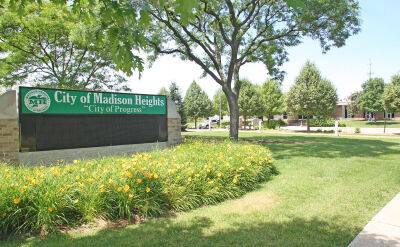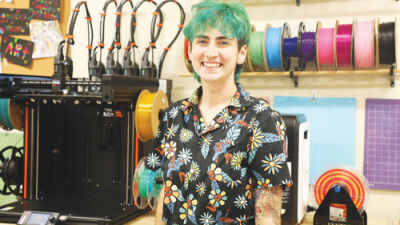MADISON HEIGHTS — While the Jewish community in Detroit is relatively small, their history of contributions is vast, ranging from the doctor who helped eradicate smallpox, to one of the most famous film producers in the world.
In recent weeks, several programs in Madison Heights have shined a light on this legacy, including presentations at the Madison Heights library and a bus tour to historical sites in the area.
The Madison Heights Human Relations and Equity Commission coordinated the events. Sean Fleming, a member of the Madison Heights City Council who is Jewish, had reached out to the Jewish Historical Society of Michigan to arrange it. He said it’s a way to foster appreciation for the impact of Jewish people, and he would like to see it done for other minorities as well.
“As a Jewish person who grew up in the very diverse community of Oak Park, I feel that the city of Madison Heights, which is also very diverse, is a place where we should be promoting each other’s cultures,” Fleming said. “By teaching people about each other’s cultures, any fear they may have of the differences or unknowns will fade away. They will not only be more tolerant, but they will feel more connected to their neighbors. They won’t feel like strangers.”
Catherine Cangany is the executive director of the JHSM. She listed many notable Detroit Jews with far-reaching impacts.
Examples include Ben and Perry Feigenson, the Jewish bakers who invented Faygo in Detroit in 1907; Jewish civil servant David Heineman and architect Albert Kahn, who created the Belle Isle Aquarium; Dr. Larry Brilliant, the Jewish epidemiologist who helped eradicate smallpox; Emma Lazaroff Schaver, the soprano who joined the United Nations’ first cultural mission to Europe after World War II; and Jerry Bruckheimer, one of Hollywood’s biggest names, with films ranging from “Flashdance” to “Pirates of the Caribbean.”
“Despite only ever constituting — at most — 4% of Detroit’s population, Jews have been making history here since 1762,” Cangany said via email.
In Detroit, many of the first Jews were merchants who arrived soon after the city switched from French control to British control in 1760. Most arrived from Germany, by way of Britain.
In the 1760s and 1770s, the Jewish community operated a fur trading firm that nearly drove the Hudson’s Bay Company, its rival, to bankruptcy. Hudson’s was once the oldest and largest corporation in Canada. Cangany said that no structures remain from Detroit’s colonial era, but there is a historical marker at Milliken State Park about Detroit’s first Jewish resident, Chapman Abraham.
She said that Detroit’s Jewish population remained very small until 1881, when thousands of Jews began fleeing genocide in Eastern Europe, settling in Michigan where they were drawn to economic opportunities in the auto industry, including Henry Ford’s “$5 a day” wages. Others worked in support industries that helped the auto industry succeed.
At first, Detroit’s Jews lived largely around Hastings Street, between Grand Circus Park and Eastern Market. It was a tight-knit working-class neighborhood where residents could easily walk to synagogues, and where Yiddish was spoken on each street corner. Local businesses and organizations supported the community as well, with Kosher food, English-language lessons, job and housing assistance, and other services.
From there, Cangany said, the Jewish community adapted and began moving north and west into higher-quality and more spacious housing in neighborhoods such as Brush Park, Boston-Edison and Dexter Linwood. As the Jewish community moved out of the Hastings Street area, more Black residents moved in, and the street took on vibrant new life, home to more than 100,000 people at its peak. The neighborhood was then razed beginning in 1949, setting the stage for the construction of Interstate 375.
The JHSM is currently creating an exhibit about everyday life on Hastings Street at the Detroit Historical Museum, which will open next year, from April 20 to July 14.
“We are focusing especially on the period from 1880 to 1930, but are also partnering with Black historians and archivists to tell the neighborhood’s later history,” Cangany said. “As with most of our initiatives, we hope exhibit attendees will appreciate the ingenuity, tenancy and humanity of some of the city’s forebears. As we like to say, Michigan’s Jewish history is for everybody.”
Quinn Wright, a member of the Madison Heights City Council serving on the HREC, said that the commission would like to see additional programming in the near future, such as a bus trip to the Charles H. Wright Museum of African American History.
“I think it’s important for us to highlight the struggle of all cultures, particularly those who are still facing persecution today,” Wright said. “I think this will give us an opportunity to provide a different cultural experience for our city.”
Madison Heights Mayor Roslyn Grafstein is Jewish. She feels it’s important to maintain good relationships between the many diverse groups that call Madison Heights home.
“Recently, the (American Islamic Community Center) reached out to me because they were having an event. They wanted extra police patrols in the area, because they were a bit concerned (about possible hate crimes). I said we will take care of it, and that put them at ease,” Grafstein said. “Everyone should be able to practice their faith and pray in safety.”
She also recalled an incident in April, where the Woodward Avenue Shul — a Jewish cultural center in Royal Oak — was vandalized with anti-Semitic graffiti.
“When that happens, just miles and minutes from where we live, it should be concerning to all — and not just the Jewish people,” Grafstein said. “If someone is going to attack one group because of their culture, there’s nothing to stop them from turning around and attacking another. This is a fear that every minority has in common.
“I remember back when I lived in Toronto, there was a synagogue and a mosque next door to each other,” she said. “They shared not only parking, but also security services, because they share that same concern (about hate crimes).”
She said that educational efforts such as the JHSM programs help combat ignorance and normalize differences, strengthening the community.
“I’m hoping there will be more efforts like this for other cultures,” Grafstein said. “It’s important for people of all cultures to support each other.”
 Publication select ▼
Publication select ▼




















